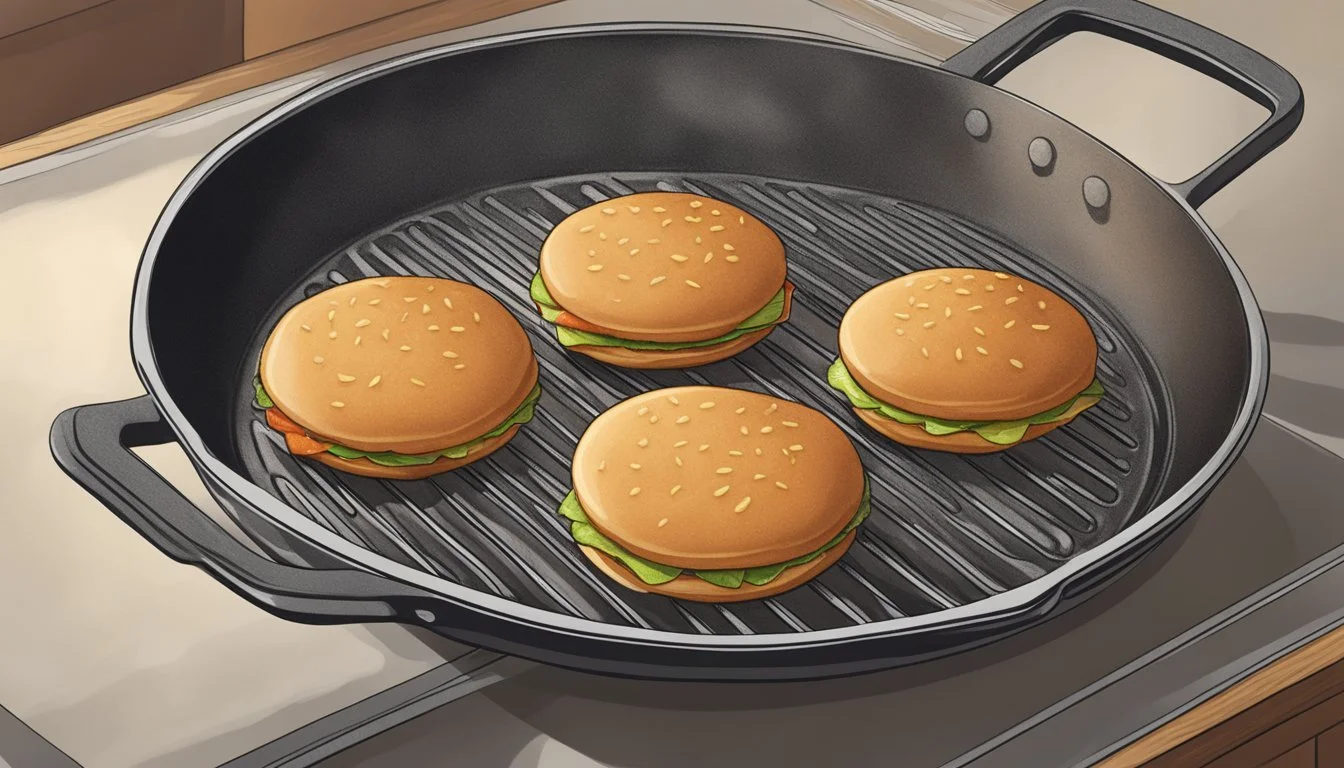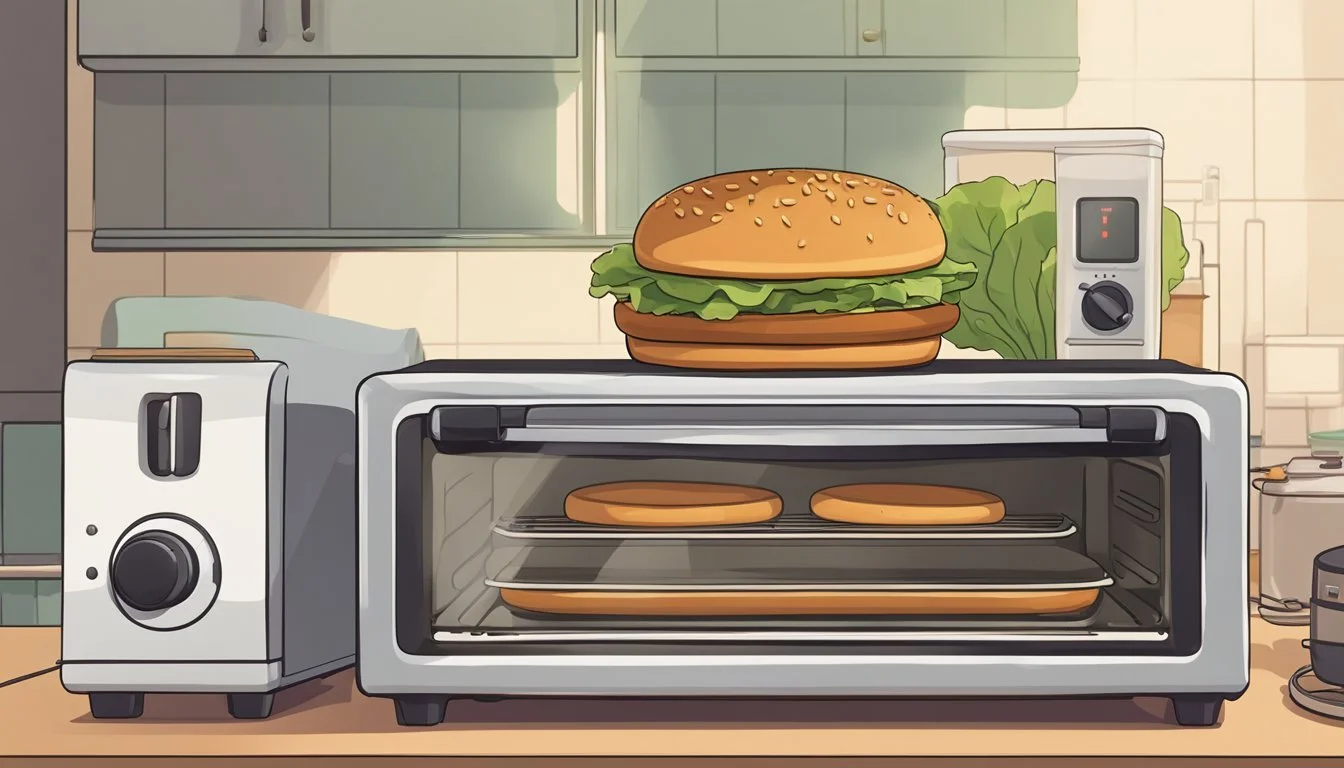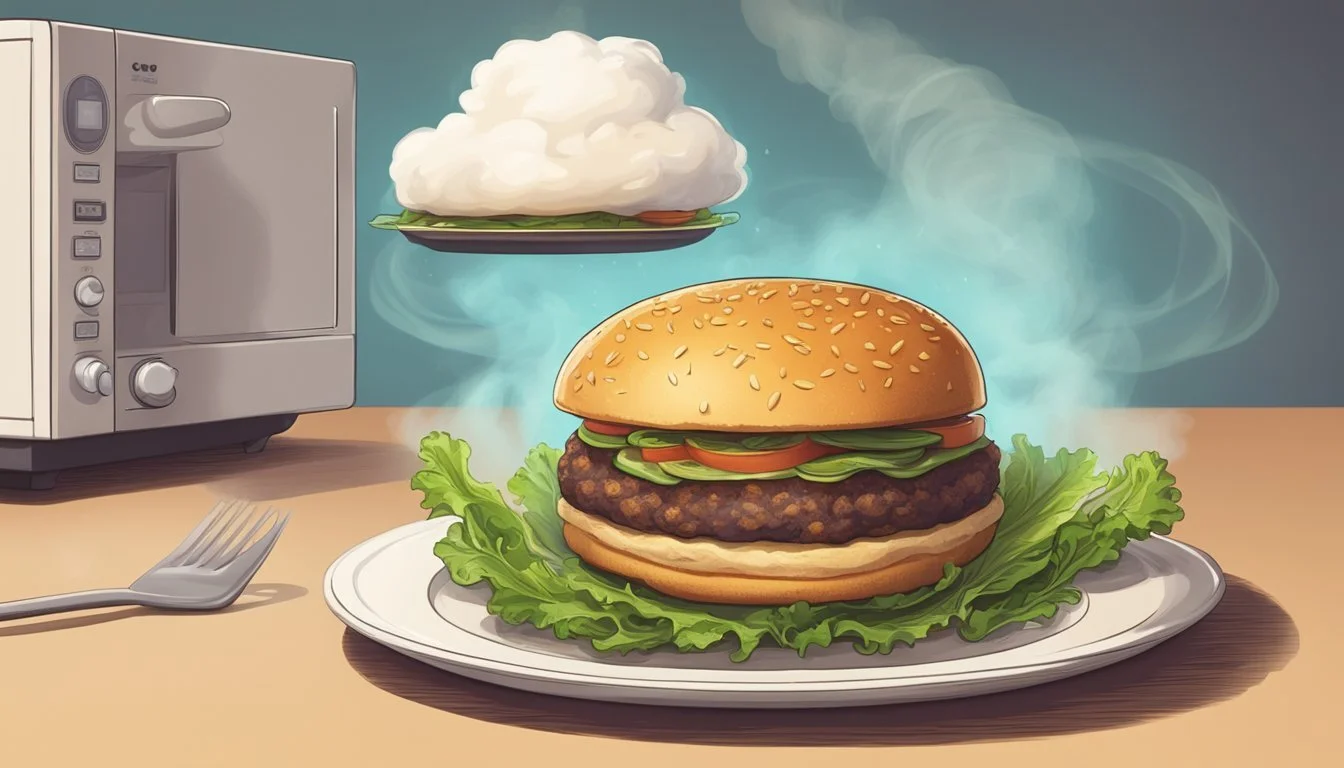Best Way to Reheat Veggie Burger
Tips for a Perfectly Moist Patty and Soft Bun
Reheating a veggie burger to perfection involves finding the right balance of heat and moisture to restore the patty's tenderness without letting it become dry or the bun soggy. Veggie burgers, unlike their meat counterparts, pose a unique challenge—they're often made with ingredients like beans, grains, and vegetables that can dry out or become too mushy if not reheated carefully. It is important to choose a method that will warm the veggie burger evenly, keeping the patty moist and the bun soft.
The oven is commonly recommended for reheating veggie burgers as it provides consistent, all-around heat. To maintain the patty’s moisture, a small amount of water or vegetable broth can be added to the baking sheet, which also prevents sticking and promotes even heating. When it comes to the bun, wrapping it in foil can help to retain its original texture. The goal is to replicate the fresh-off-the-grill experience where the burger is heated through, but retains the quality of a freshly cooked meal.
Suitable reheating techniques can elevate a previously cooked veggie burger to a meal that tastes thoughtfully prepared, rather than leftover. The key is to apply gentle heat and to monitor closely, ensuring the burger doesn’t overcook, as plant-based ingredients are particularly susceptible to textural changes. By implementing these strategies, one can enjoy a reheated veggie burger that is both delicious and satisfying, with a patty that remains juicy and a bun that stays tender.
Understanding the Basics of Reheating Veggie Burgers
Reheating a veggie burger correctly is crucial for maintaining its moisture and ensuring the bun remains soft. A dry patty or hard bun can significantly detract from the enjoyment of the burger.
Importance of Patty Moisture
When it comes to reheating veggie burgers, moisture retention in the patty is a top priority. Unlike traditional meat patties, veggie burgers often rely on a mix of vegetables, grains, and legumes, which can dry out more quickly when reheated improperly. It's essential to apply a gentle heat that warms the patty without extracting its natural juices. Adding a small amount of water or vegetable broth to the patty before reheating can provide steam and aid in moisture retention. Using a preheated oven at 350°F and baking for 10-12 minutes can ensure the patty is heated through while maintaining its texture.
Role of Bun Softness
The bun is an integral part of the veggie burger experience. It should be soft, yet structurally sound to support the patty and toppings. Overheating can lead to a tough, chewy texture, which is undesirable. Wrapping the bun in foil can prevent it from drying out in the oven. Alternatively, a damp paper towel can be used when reheating a bun in the microwave, creating a steaming effect that keeps the bun soft. If the bun and patty are reheated together, particular attention should be paid to avoiding too high a temperature, which could compromise the bun's softness.
Pre-Reheating Preparation Steps
Before reviving your veggie burger to its former glory, adhering to proper preparation steps ensures both the patty and the bun are optimally reheated. It begins with one crucial step: allowing the burger to adjust to room temperature.
Bringing Veggie Burgers to Room Temperature
To promote even reheating and maintain the burger's moisture, one should take the veggie burger out of the refrigerator and let it sit for a short period. This step is pivotal for a few reasons:
Burger Patty: A chilled patty straight from the refrigerator will likely reheat unevenly, with the outside potentially becoming too hot before the inside has warmed sufficiently.
Buns: Similarly, cold buns can become tough or overly chewy if not brought to room temperature before reheating.
Always remember:
Let the veggie burger rest for 10 to 15 minutes at room temperature before reheating.
Evidence of readiness includes the patty losing its refrigerator chill and becoming more pliable to touch, while the bun should feel less firm and cold.
Reheating in the Oven
Reheating a veggie burger in the oven can ensure that it remains moist and its bun soft. The key lies in regulating the temperature and handling the components separately to preserve texture and flavor.
Preparing the Oven
Before reheating the veggie burger, one must preheat the oven. This step ensures a consistent cooking environment and helps prevent the burger from drying out. For optimal results, the oven should be preheated to 400 degrees Fahrenheit (200 degrees Celsius). The use of aluminum foil is beneficial, as it can protect the burger from direct heat and retain moisture.
Oven Reheating Technique
When it comes to the reheating technique, the veggie burger should be disassembled. The patty and the bun should be handled separately to achieve the desired outcome:
Reheating the Patty:
Wrap the veggie burger patty in aluminum foil to keep it moist.
Place the wrapped patty on a baking sheet.
Heat for about 2-3 minutes, then carefully flip the patty and continue to heat for another 2-3 minutes or until it's evenly warmed through.
Reheating the Bun:
If the bun is too dry, a light brushing of water can re-introduce moisture.
Place the bun halves, cut side up, directly on the oven rack or on a separate baking sheet.
Toast them in the oven for no more than 1-2 minutes to avoid over-crunchiness.
This technique will help ensure that the patty remains juicy and the bun regains a gentle warmth and softness, bringing leftovers close to their original state.
Using a Microwave for Quick Reheating
When reheating a veggie burger in the microwave, the primary goals are to maintain the patty's moisture and keep the bun from becoming soggy. The microwave offers a fast and effective reheating method if done correctly, addressing these critical aspects.
Microwaving Veggie Burgers
Place the veggie patty on a microwave-safe plate, and consider wrapping it in a paper towel to absorb excess moisture. To preserve moisture, sprinkle a few drops of water on the patty before heating. Use these settings as a guideline:
Power Level: Medium (50% power)
Time: 1 minute (check and add more time in 30-second intervals)
Heat the patty separately from the bun to avoid a soggy bun.
Avoiding Sogginess
For the bun, wrap it in a dry paper towel which will help absorb steam and prevent sogginess. Then, microwave using these settings:
Power Level: Medium (50% power)
Time: 10 to 15 seconds
Check for warmth and if necessary, continue to heat in 5-second intervals until the desired temperature is reached. The key is to heat the bun just enough to make it warm and soft but not so much that it turns chewy or tough.
Reheating on the Stovetop
When reheating a veggie burger on the stovetop, one must pay attention to maintaining the patty's moisture and keeping the bun soft. This method allows for precise control of the heat and can infuse the food with additional flavor if done correctly.
Skillet Method for Patties
One should heat a skillet over a medium flame and consider adding a small pat of butter to prevent sticking and to add a bit of richness. Then, the veggie burger patty can be placed in the skillet.
Heat: Medium
Time: Approximately 3-4 minutes per side
Additional Tips:
Covering the skillet with a lid can trap steam and help keep the patty moist.
Consider flipping the patty once to ensure even heating.
Using a Frying Pan for Buns
For the buns, heating a separate frying pan on low heat is recommended. A touch of butter may be applied to the inner surfaces of the buns before placing them in the pan.
Heat: Low
Time: About 1 minute per side
Additional Tips:
One must avoid overheating, as it can dry out or burn the buns.
Pressing down gently on the buns can give them a slight crispiness while keeping the inside soft.
Utilizing an Air Fryer for Reheating
When it comes to reheating a veggie burger, using an air fryer can ensure the patty remains juicy while reintroducing crispness to the bun. The following subsections will guide you through the necessary steps for optimal reheating using an air fryer.
Setting Up the Air Fryer
One should start by preheating the air fryer to 375°F. This temperature is effective for warming through the patty without draining its moisture. Take the veggie burger apart, separating the patty from the bun, and place the patty in the air fryer basket to avoid sogginess.
Preheat Air Fryer to 375°F (Preheating Time: 3-5 minutes)
Place veggie patty in the air fryer basket
Achieving the Best Results
For the patty:
Reheat for 3-4 minutes, checking halfway to ensure it doesn't dry out.
For the bun:
Add the bun to the air fryer during the last minute of reheating if a slight crispness is desired.
By handling the components separately, the patty will stay juicy and the bun will retain a soft inner texture with a lightly crisp exterior.
Patty: 3-4 minutes at 375°F
Bun: 1 minute at 375°F (optional for crispness)
Toaster and Toaster Oven Alternatives
Using a toaster or toaster oven presents a convenient method to reheat veggie burgers while keeping the patty moist and the bun soft.
Toasting the Buns
A veggie burger's bun requires attention to retain its softness. One may lightly toast just the buns in a toaster for a brief period, ensuring they don't dry out or become too crisp. This step is separate from reheating the patty itself and should be done just before the patty is ready to keep the buns warm.
Toaster Oven Reheating Method
For the veggie patty, a toaster oven serves as an effective tool for reheating. By setting the toaster oven to a moderate temperature, one can achieve an evenly reheated patty with a favorable texture. Here's a precise method:
Place the veggie burger patty on a metal rack inside the toaster oven to promote even heating and allow any excess moisture to drip away, avoiding sogginess.
Reheat burgers at 350°F for about 4-6 minutes, then check the warmth. Flip the patty halfway through the reheating process to ensure both sides are heated properly.
If the patty isn't sufficiently warm, continue to heat in increments of 1 minute, checking the temperature each time to prevent overheating and drying out the patty.
Additional Tips for Enhanced Flavor and Texture
When reheating a veggie burger, the goal is to retain moisture in the patty while keeping the bun soft. Achieving this balance often requires additional steps to enhance flavor and texture.
Using Condiments and Toppings
To ensure a moist and flavorful veggie burger post-reheating, one should consider the strategic use of condiments and toppings.
Lettuce, Tomato, Onion: Add fresh lettuce, tomato slices, and onion after reheating to provide a crisp contrast to the warm patty.
Ketchup, Mayonnaise, Mustard: Apply these condiments post-reheat to avoid sogginess; they help in adding moisture and tanginess.
Cheese: If adding cheese, place it on the patty during the last minute of reheating to allow it to melt evenly.
Worcestershire Sauce: A small splash on the patty before reheating can introduce savory depth.
Proper Storage Tips for Leftovers
Properly storing leftover veggie burgers is crucial for maintaining quality when reheating.
Airtight Containers: Store patties and buns in separate airtight containers to prevent moisture transfer.
Refrigeration: Keep refrigerated at a consistent temperature to preserve freshness.
Separation of Components: Wrap buns and store toppings like lettuce, tomato, and onion separately from the patties to maintain their texture.
Serving Considerations
When serving a reheated veggie burger, it's essential to complement its flavors and textures with appropriate sides and present it in an appetizing manner.
Accompanying Sides
For a balanced meal, choose sides that will enhance the veggie burger experience without overpowering its taste. One might consider:
Crisp potato fries: They add a satisfying crunch and are a classic pairing.
Pickles: Their acidic tang adds a flavorful contrast to the burger.
Salad with vinaigrette dressing: It offers a fresh counterbalance.
Remember that sides should not only be flavorful but also maintain a textural balance with the burger itself.
Presentation for Appeal
The presentation is just as important as the taste. To ensure the veggie burger looks as good as it tastes, take care with these elements:
Soft bun: Gently toast it for warmth without drying it out.
Cheese: If including cheese, ensure it’s melted appropriately for visual appeal.
Sauce: Drizzle or spread evenly for an even flavor distribution.
Layering: Assemble the burger in an appealing way that showcases the ingredients.
The burger's color, layering, and sauce distribution should entice the diner before the first bite.
Safety and Best Practices
Reheating a veggie burger correctly is essential not only for taste but also for safety. Adhering to the guidelines for safe internal temperatures and avoiding cross-contamination ensures that the veggie burger is satisfying and safe to consume.
Checking for Safe Internal Temperature
It is crucial to ensure that a reheated veggie burger reaches an internal temperature of 165°F. This temperature is the minimum recommended by food safety authorities to prevent foodborne illnesses. The use of a food thermometer can confirm the patty's internal temperature has achieved safety standards. Here's a simple process for checking the temperature:
Insert the thermometer: Halfway into the patty's center.
Read the temperature: Wait until the temperature reading stabilizes.
Verify the temperature: Ensure it's at or above 165°F.
Preventing Cross-Contamination
When reheating a veggie burger, one must be vigilant to prevent cross-contamination, which can occur when bacteria from raw foods or unclean surfaces are transferred to the veggie burger. To avoid this:
Use separate utensils and surfaces for raw and cooked foods.
Clean kitchenware: Thoroughly wash anything that comes into contact with the veggie burger.
Handle with care: Ensure hands are washed before and after handling the veggie burger.





